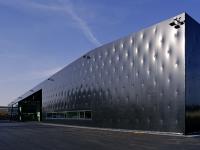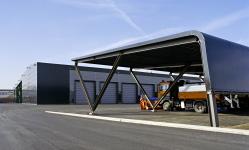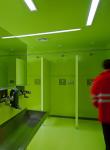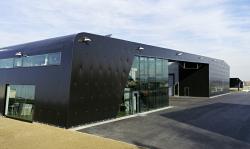The plan for the garage and office building for the state government of Upper Austria resulted from a limited open design competition in 2002 in which Caramel took first place.
Although the organizer’s brief called for a linear alignment of the functional units, Caramel arranged the main functional units in a U-configuration around a transparent covered interior yard. Situated in the west wing are the two-level office building as well as the employees’ changing rooms and washrooms; directly adjacent to these are the special-service shops, e.g. the sandblasting and painting booths.
Along the front of the complex is the two-level warehouse, which connects to the east garage, a 20-meter wide hall that can be driven into from both sides and allows daylight to enter through glass-reinforced plastic doors. The office wing lies at the far side of the garage hall area at the front of the works yard.
The building as a whole unfolds outward along its length, emerging as a gentle slope from the terrain and rejoining it in its imaginary lengthwise projection, in the 72-meter-long shed roof.
With the exception of a number of warehouses and fire protection walls, the building was built using a three-row, very efficient steel-frame construction method. The construction deadline of roughly 18 months was met despite a harsh winter by using mass-produced, prefabricated steel beams and columns. A total of 367 tons of steel were used. The largest spans of 20 m were made possible by employing 1.60-meter-high plate girders.
2005
2006
The materiality of the metal is emphasized by the application of micaceous iron oxide paint and contrasts sharply with the translucent glass-reinforced plastic door elements and glazed surfaces.
The contrasts between the different materials in color as well as in haptic quality are a striking feature of the architecture; one notices them in many places inside and outside the building.
The 24 glass-reinforced plastic doors are positioned between the fixed glazing and set in semicircular doorframes. Like the roof and the closed façade, the doorframes are composed of a black synthetic membrane (EVA). This gives the building its consistent homogeneous appearance; the rivets holding the façade in place reinforce the impression of glossy plasticity.
The works yard also profits from the steel construction. The 6 x 20 m spaces are covered by two-layer pneumatic panels (arch rise: 1.25 m), which keep their form through an internal air pressure of 0.05 bars (the air pressure of tires is roughly 1.9 bars).
The pneumatic panels, which are made of a 0.25 mm thick translucent ETFE membrane, support loads of 14 t, with a max. load capacity of 30 t.
The matter-of-fact and industrial vernacular of the building’s interior is intentional, making use of only a few materials, e.g. steel and glass.
With the exception of the bright green washrooms, the color scheme tends to keep a low profile, sticking mainly to white and anthracite.
The new central garage gives form to its structure-less surroundings and creates an identity and modernity that extends well past the walls of the building itself.
Architcture: Caramel architekten
Photographer: Hertha Hurnaus
Favorited 1 times









